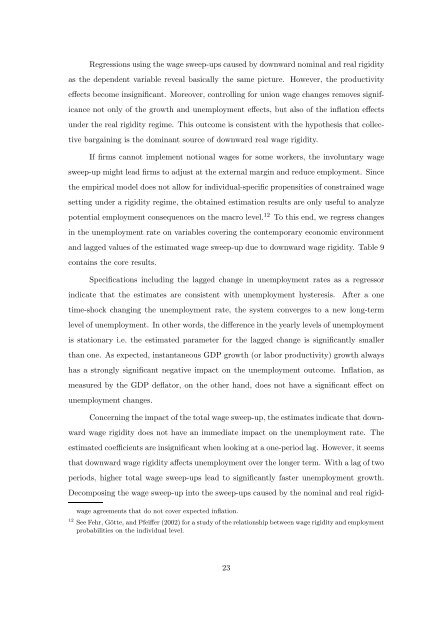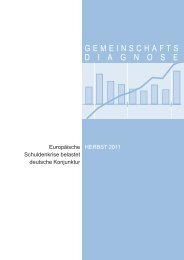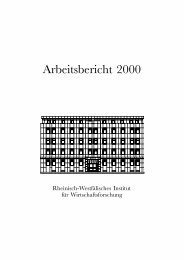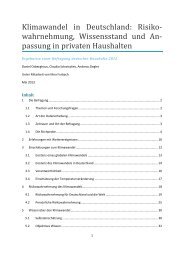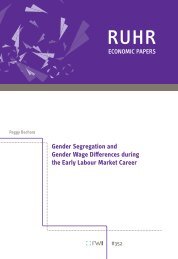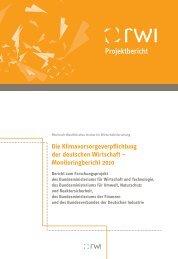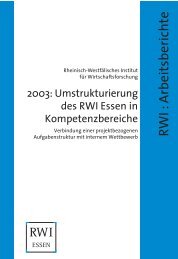RW I:Discussion Papers - Rheinisch-Westfälisches Institut für ...
RW I:Discussion Papers - Rheinisch-Westfälisches Institut für ...
RW I:Discussion Papers - Rheinisch-Westfälisches Institut für ...
You also want an ePaper? Increase the reach of your titles
YUMPU automatically turns print PDFs into web optimized ePapers that Google loves.
Regressions using the wage sweep-ups caused by downward nominal and real rigidity<br />
as the dependent variable reveal basically the same picture. However, the productivity<br />
effects become insignificant. Moreover, controlling for union wage changes removes significance<br />
not only of the growth and unemployment effects, but also of the inflation effects<br />
under the real rigidity regime. This outcome is consistent with the hypothesis that collective<br />
bargaining is the dominant source of downward real wage rigidity.<br />
If firms cannot implement notional wages for some workers, the involuntary wage<br />
sweep-up might lead firms to adjust at the external margin and reduce employment. Since<br />
the empirical model does not allow for individual-specific propensities of constrained wage<br />
setting under a rigidity regime, the obtained estimation results are only useful to analyze<br />
potential employment consequences on the macro level. 12 To this end, we regress changes<br />
in the unemployment rate on variables covering the contemporary economic environment<br />
and lagged values of the estimated wage sweep-up due to downward wage rigidity. Table 9<br />
contains the core results.<br />
Specifications including the lagged change in unemployment rates as a regressor<br />
indicate that the estimates are consistent with unemployment hysteresis. After a one<br />
time-shock changing the unemployment rate, the system converges to a new long-term<br />
level of unemployment. In other words, the difference in the yearly levels of unemployment<br />
is stationary i.e. the estimated parameter for the lagged change is significantly smaller<br />
than one. As expected, instantaneous GDP growth (or labor productivity) growth always<br />
has a strongly significant negative impact on the unemployment outcome. Inflation, as<br />
measured by the GDP deflator, on the other hand, does not have a significant effect on<br />
unemployment changes.<br />
Concerning the impact of the total wage sweep-up, the estimates indicate that downward<br />
wage rigidity does not have an immediate impact on the unemployment rate. The<br />
estimated coefficients are insignificant when looking at a one-period lag. However, it seems<br />
that downward wage rigidity affects unemployment over the longer term. With a lag of two<br />
periods, higher total wage sweep-ups lead to significantly faster unemployment growth.<br />
Decomposing the wage sweep-up into the sweep-ups caused by the nominal and real rigidwage<br />
agreements that do not cover expected inflation.<br />
12 See Fehr, Götte, and Pfeiffer (2002) for a study of the relationship between wage rigidity and employment<br />
probabilities on the individual level.<br />
23


